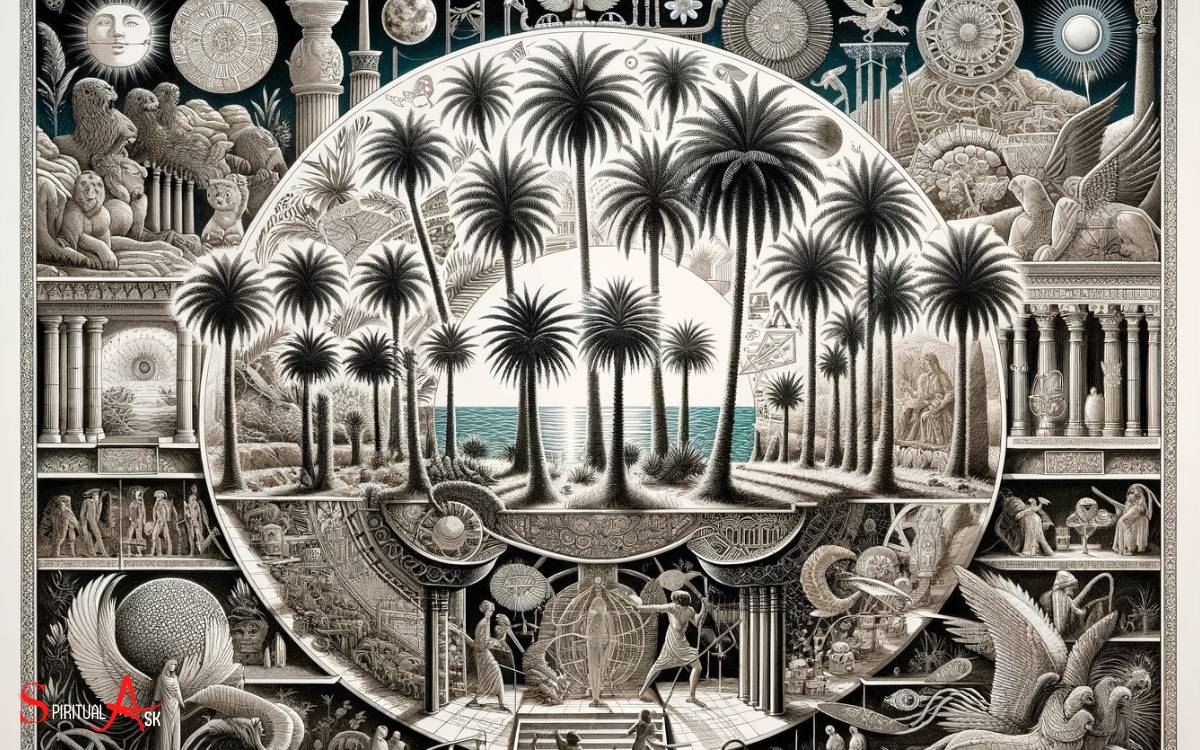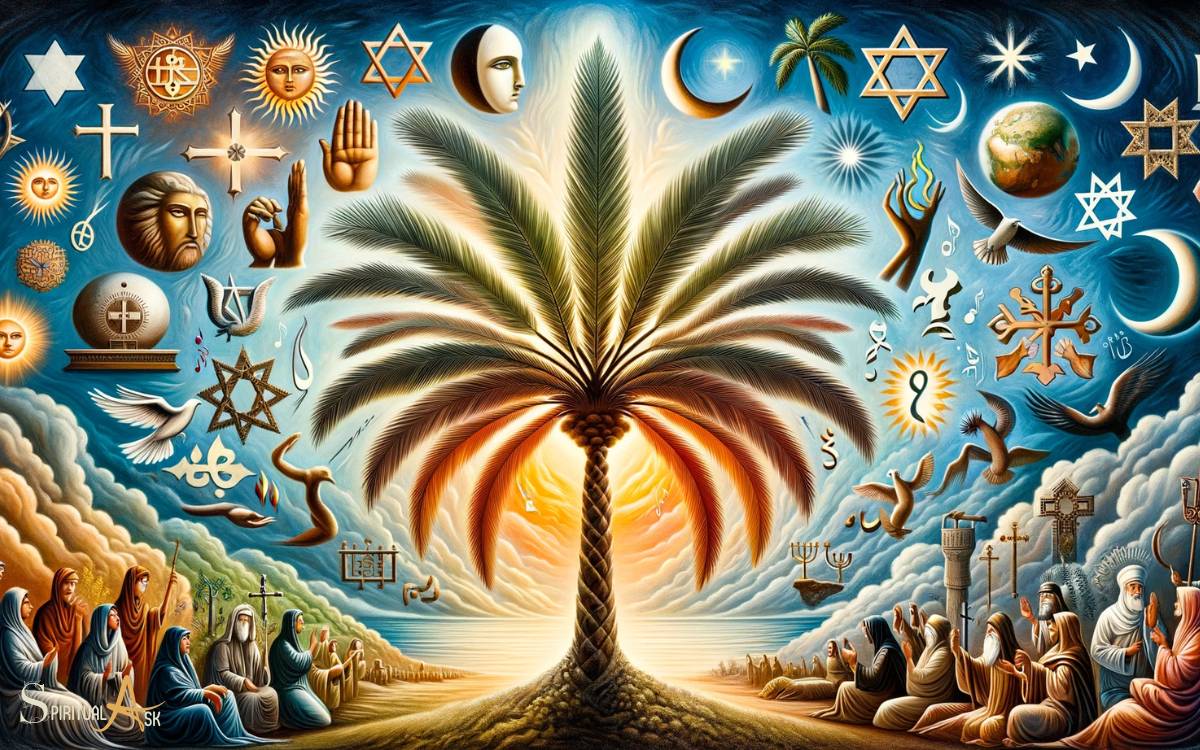Palm Tree Symbolism Spiritual Meaning: Victory, Peace!
The palm tree is a powerful symbol in various cultures and spiritual traditions, often representing victory, peace, and eternal life. Its presence in religious texts and iconography underscores its importance as a sign of triumph over adversity and a connection to the divine.
Palm trees have long been significant in symbolism, carrying various meanings that intertwine with spirituality and cultural traditions.
Here’s a breakdown of the palm tree’s spiritual symbolism:

Key Takeaway
Historical Significance of Palm Trees
I’ve always been fascinated by the historical significance of palm trees, as they’ve played a crucial role in the traditions and cultures of many ancient civilizations.

The palm tree’s significance dates back to ancient times, where it was seen as a symbol of victory, peace, and fertility.
In ancient Egypt, the palm branch was a symbol of resurrection and eternal life, often depicted in hieroglyphics and tombs. The Greeks and Romans associated palm trees with victory and used them to honor triumphant warriors and athletes.
Additionally, in the Jewish faith, palm branches are used to celebrate Sukkot, representing peace and plenty.
This rich historical significance of palm trees has shaped their cultural representations and meanings across various civilizations, making them a symbol of resilience, triumph, and spirituality.
Cultural Representations and Meanings

The cultural representations and meanings of palm trees are deeply ingrained in various ancient civilizations and continue to hold significance in contemporary societies.
- In ancient Mesopotamia, the palm tree was a symbol of fertility and abundance, often associated with the goddess Inanna.
- It represented the cycle of life, death, and rebirth and was revered as a sacred tree.
- In ancient Egypt, the palm was a symbol of resurrection and eternal life, often depicted in hieroglyphics and used in burial rituals.
These cultural representations have transcended time and continue to influence art, literature, and societal customs.
Understanding the historical and cultural significance of palm trees provides insight into their enduring symbolism in different religions and spiritual beliefs.
Spiritual Symbolism in Different Religions

I’m excited to explore the spiritual symbolism of palm trees in different religions. From their significance in Hinduism to their representation in Christianity and Buddhism, palm trees hold deep spiritual meanings across various faiths. In Hinduism, for instance, the palm tree symbolizes victory and triumph, often associated with divine blessings. Similarly, in Christianity, palm branches are emblematic of peace and victory, particularly during the celebration of Palm Sunday. Just as palm trees bear profound spiritual meanings, the spiritual meanings of lotus flower tattoos also reflect growth, purity, and enlightenment, making both elements rich in symbolic representation across multiple cultures.
It’s fascinating to uncover the unique interpretations and symbolism associated with palm trees in each religious context.
Symbolism in Hinduism
In Hinduism, palm trees hold significant spiritual symbolism. They are often associated with victory, triumph, and peace.
Here’s a closer look at the spiritual symbolism of palm trees in Hinduism:
Victory and Triumph: The palm tree is a symbol of victory of good over evil in Hindu mythology. It represents the triumph of righteousness and signifies the eradication of obstacles.
Peace and Prosperity: The presence of palm trees is believed to bring peace and prosperity. It is seen as a symbol of auspiciousness and abundance, often associated with the blessings of the divine.
Palm Tree in Christianity
Continuing from the previous subtopic, let’s explore the significance of palm trees in Christianity and their spiritual symbolism in various religions.
In Christianity, the palm tree is a symbol of victory, triumph, and peace. It is often associated with Jesus Christ’s triumphal entry into Jerusalem, where people waved palm branches to welcome him.
This event, known as Palm Sunday, is celebrated by Christians worldwide. The palm tree’s tall, upright trunk is seen as a representation of the steadfastness and uprightness of believers.
Additionally, in other religions, such as Judaism and Islam, palm trees are also regarded as significant symbols of peace, fertility, and abundance.
The palm’s ability to thrive in arid conditions has further led to its association with resilience and endurance in various spiritual traditions.
Significance in Buddhism
The palm tree’s significance in Buddhism is marked by its representation of enlightenment and spiritual growth.
In Buddhism, the palm tree holds deep spiritual symbolism, signifying:
- Unwavering Faith and Stability: Just as the palm tree’s roots firmly anchor it into the ground, Buddhists are encouraged to have steadfast faith and stability in their spiritual practice.
- Victory over Obstacles: The palm tree’s ability to thrive in harsh conditions symbolizes the Buddhist belief in overcoming obstacles and achieving spiritual growth despite adversity.
The palm tree’s presence in Buddhist teachings serves as a powerful reminder of the potential for spiritual development and the capacity to rise above challenges on the path to enlightenment.
Palm Trees as a Symbol of Resilience

Feeling a deep connection to the palm tree’s symbolism, I recognize its representation of resilience in the face of adversity. The palm tree’s ability to thrive in harsh conditions, bending but not breaking in the winds of a storm, serves as a powerful metaphor for resilience.
Its deep roots enable it to withstand the strongest of hurricanes, symbolizing the strength and fortitude needed to endure life’s challenges.
The palm’s ability to not only survive but to continue growing and flourishing despite difficult circumstances is a reminder that we too can weather the storms that come our way.
Embracing the palm tree’s symbolism of resilience can inspire us to stand tall and unwavering in the face of adversity, knowing that we have the inner strength to endure and overcome. This resilience is a key aspect of the palm tree’s profound spiritual symbolism.
Palm Trees and Enlightenment
When it comes to palm trees and enlightenment, I find their symbolism truly fascinating. The serene and tranquil presence of palm trees often represents a sense of inner peace and spiritual growth.

Additionally, their deep-rooted connection to nature serves as a powerful reminder of our interconnectedness with the world around us.
Symbol of Serenity
Often, I find myself drawn to the palm tree as a symbol of serenity, representing a path towards enlightenment and inner peace.
- The gentle rustling of palm fronds in the breeze creates a calming atmosphere, fostering a sense of tranquility and harmony within.
- This peaceful ambiance mirrors the stillness and clarity sought in meditation and spiritual practices, guiding individuals towards a state of serenity and enlightenment.
- The resilience of the palm tree, with its ability to bend without breaking in strong winds, serves as a reminder of the importance of flexibility and adaptability in achieving inner peace.
Embracing the symbolism of the palm tree as a representation of serenity can inspire us to cultivate a peaceful mindset, navigate through life’s challenges with grace, and embark on a journey towards spiritual enlightenment.
Spiritual Growth Representation
As I delve into the spiritual growth representation of palm trees and enlightenment, it becomes evident that the symbolism of serenity seamlessly transitions into a deeper understanding of inner transformation and awakening.
Palm trees, with their ability to bend without breaking in the face of strong winds, symbolize resilience and flexibility, qualities essential for spiritual growth. Their upward growth represents the upward movement of the spirit towards enlightenment.
Just as a palm tree’s roots grow deep to provide stability, spiritual growth requires a strong foundation in mindfulness and self-awareness. The palm tree’s ability to thrive in various climates reflects the adaptability and openness necessary for spiritual development.
Embracing the symbolism of palm trees in the context of spiritual growth encourages one to remain resilient, flexible, and open-minded on the path towards enlightenment.
This understanding of palm trees’ spiritual significance naturally leads to exploring their connection to nature.
Connection to Nature
Continuing from the exploration of palm trees’ spiritual symbolism and their representation of spiritual growth, the connection to nature further emphasizes their role in enlightenment and self-awareness.
Harmony with the Environment
- Palm trees, with their deep roots and swaying fronds, symbolize the harmony between humans and the natural world.
- Observing their resilience in adverse conditions encourages us to seek balance and adaptability in our own lives, fostering a deeper connection to the environment.
This connection to nature serves as a constant reminder of the interconnectedness of all living beings, promoting mindfulness and introspection.
The palm tree’s presence in natural landscapes and its ability to thrive in diverse conditions inspire us to embrace change, seek inner peace, and pursue enlightenment through a deeper connection with the world around us.
Modern Interpretations and Applications

In my experience, palm trees have become increasingly popular symbols in modern spirituality and self-care practices.
The image of a palm tree often represents resilience, strength, and inner peace, making it a powerful symbol for those seeking balance and tranquility in today’s fast-paced world.
Many people find solace in the idea of the palm tree bending but not breaking in the face of strong winds, symbolizing the ability to adapt and endure challenges without losing one’s inner core.
In modern applications, palm tree imagery is often used in mindfulness practices, meditation spaces, and wellness products to evoke a sense of calm and stability.
Whether it’s through visualizations, artwork, or physical representations, the palm tree continues to serve as a reminder to stay grounded and weather life’s storms with grace.
Conclusion
Palm trees have deep spiritual meanings in various cultures and religions, symbolizing resilience, enlightenment, and spiritual growth.
As the saying goes, “In the shade of a palm tree, even a stranger finds peace.” It’s fascinating to see how this iconic tree continues to inspire and uplift people across the world, reminding us to stay rooted and strong in the face of adversity.






